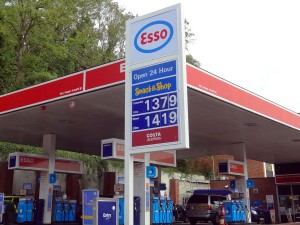 When crude oil prices go up, the prices of petrol and diesel go up pretty well straight away and by the full amount, or more, of the crude price rise. When crude prices go down, however, road fuel prices are often slow to fall; and when they do, the fall is less than the full fall in crude prices.
When crude oil prices go up, the prices of petrol and diesel go up pretty well straight away and by the full amount, or more, of the crude price rise. When crude prices go down, however, road fuel prices are often slow to fall; and when they do, the fall is less than the full fall in crude prices.
Click on charts below for a larger version. Click here for a PowerPoint of the left-hand chart.
In response to complaints of motorists and haulage companies, the Office of Fair Trading has announced that it will investigate the link between crude prices and prices at the pump. It will report in January 2013.
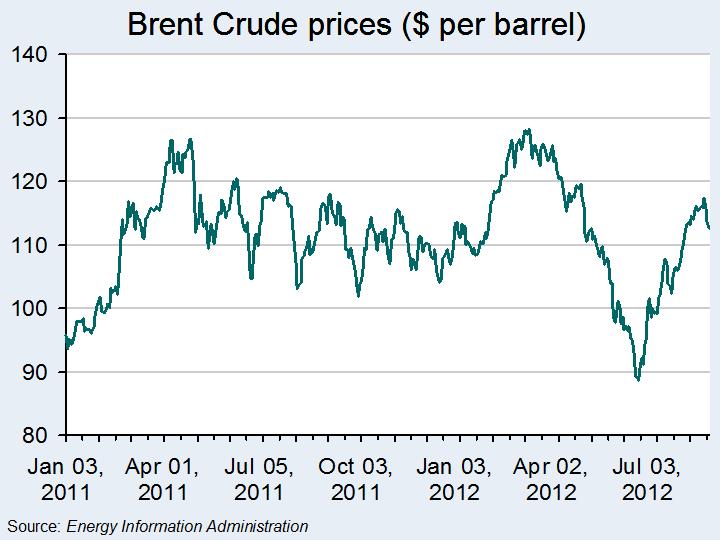
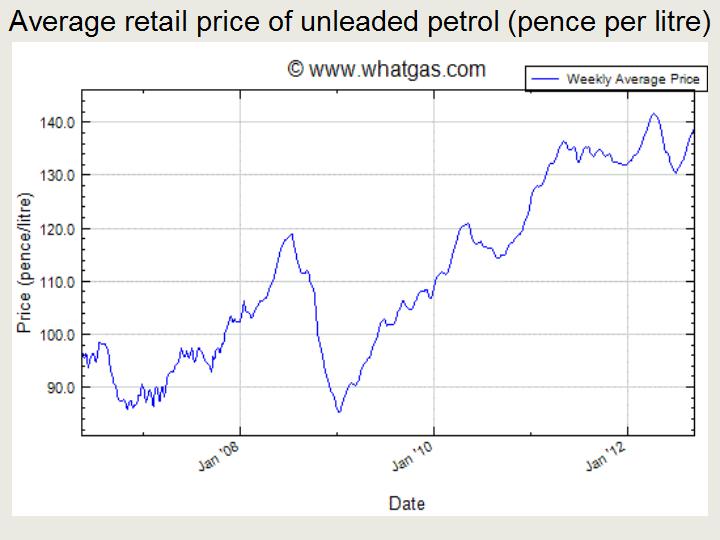
The review will consider questions of competition and market power. In particular, it will look at the power of the oil companies in determining the wholesale price of road fuel.
It will also examine the retail fuel sector and whether supermarkets are driving out independent retailers. The claim of many independent petrol stations is that supermarkets are selling below cost as a lost leader to encourage people to shop in their stores. They also claim that supermarkets use their buying power to obtain fuel more cheaply.
What is more, most of the petrol stations that are not part of supermarkets are owned by the oil companies. Again, independents claim that oil companies supply fuel more cheaply to their own stations than to independents.
As a result of what many independents see as unfair competition, many are driven out of business. Today there some 9000 petrol stations in the UK; 20 years ago there were twice as many.
The following articles look at the remit of the OFT investigation and at the competition issues in the road fuel market.
Articles
 Formal inquiry tries to ease motorist pain at the pumps ITV News, Laura Kuenssberg (5/9/12)
Formal inquiry tries to ease motorist pain at the pumps ITV News, Laura Kuenssberg (5/9/12)
OFT to scrutinise retail petrol market Financial Times, Caroline Binham (5/9/12)
OFT launches probe into pump prices Channel 4 News (5/9/12)
Petrol and diesel prices: Office of Fair Trading launches competition inquiry Guardian, Terry Macalister (5/9/12)
Petrol and diesel price review is launched by OFT BBC News (5/9/12)
Are supermarkets to blame for the devastation of independent petrol retailers by deliberately selling at a loss? This is Money, Tom Mcghie and Neil Craven (8/9/12)
OFT petrol pricing probe welcomed The Grocer, Beth Phillips (7/9/12)
Private businesses welcome OFT’s fuel price investigation Talking Retail (6/9/12)
10 charges that make consumers scratch their heads BBC News Magazine, Lucy Townsend (6/9/12)
Data
Crude Oil Price Index Index Mundi
Daily Brent Crude Spot Price, 1987 to present day US Energy Information Administration
Current UK Petrol Pump Prices What Pric£?
Fuel Prices WhatGas.com
Questions
- Describe the structure of the road fuel market, from oil production through to the retailing of petrol and diesel.
- What is meant by the terms ‘monosony’ and ‘oligopsony’? Which companies in the road fuel market have significant monopsony/oligopsony power?
- What determines the price elasticity of demand for road fuel in (a) the short run; (b) the long run? What implications does this have for the value of the short-run and long-run price elasticities?
- Where is the abuse of market power likely to occour in the road fuel market?
- To what extent is it in the consumers’ interests for supermarkets to sell road fuel below average cost?
- Examine the data for pump prices and crude oil prices and establish whether there is any truth in the claim that pump prices adjust rapidly to a rise in crude prices and slowly to a fall in crude prices.
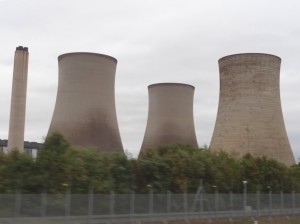 Centrica, owners of British Gas, has warned that electricity and gas prices in the UK are set to rise in the autumn. Centrica blames this on the expected rise in the costs of wholesale gas and other non-energy inputs.
Centrica, owners of British Gas, has warned that electricity and gas prices in the UK are set to rise in the autumn. Centrica blames this on the expected rise in the costs of wholesale gas and other non-energy inputs.
One of the other ‘big six’ energy suppliers, E.On, has responded by saying that it will not raise energy prices this year. Whether it will raise prices after 1 Jan next year remains to be seen.
Last autumn, household energy prices rose substantially: between 15.4% and 18% for gas and between 4.5% and 16% for electricity. This spring, in response to lower wholesale energy prices, suppliers cut prices for either electricity or gas (but not both) by around 5%.
The government and various pressure groups are encouraging consumers to use price comparison sites to switch to a cheaper supplier. The problem with this is that supplier A may be cheaper than supplier B one month, but B cheaper than A the next. Nevertheless, switching does impose some degree of additional competitive pressure on suppliers.
More powerful pressure could be applied by ‘collective switching’. This is where a lot of people switch via an intermediary company, which sources a deal from an energy supplier. This collective buying is a form of countervailing power to offset the oligopoly power of the suppliers. Such schemes are being encouraged by the Energy Minister, Ed Davey.
The other approach, apart from doing nothing, is for Ofgem, the energy regulator, to impose tough conditions on pricing. But at present, Ofgem’s approach has been to try to make the market more competitive (see also), rather than regulating prices.
British Gas owner Centrica warns of higher energy bills BBC News (11/5/12)
E.ON to keep residential energy prices unchanged in 2012 Reuters, Adveith Nair (14/5/12)
E.ON promises to hold energy prices for 5million customers in 2012 This is Money, Tara Evans (14/5/12)
British Gas owner Centrica feels cold blast from critics ShareCast, John Harrington (11/5/12)
Gas and electricity price battle lines drawn BBC News (14/5/12)
Taking on the energy giants: The co-operative insurgency gains ground Left Foot Forward, Daniel Elton (11/5/12)
Group Energy Buying hits the UK Headlines Spend Matters UK/Europe, Peter Smith (11/5/12)
Think tank calls for competition to break Big Six rip-off Energy Live News, Tom Gibson (30/4/12)
Collective switching will not fix the UK’s broken energy market Guardian, Reg Platt (27/4/12)
Make your own small switch for cheaper energy The Telegraph, Rosie Murray-West (14/5/12)
Questions
- What are the barriers to entry in the electricity supply market?
- How competitive is the retail energy market at present?
- To what extent do price comparison sites put pressure on energy companies to reeduce prices or limit price increases?
- What scope is there for collective buying of gas and electricity from the six energy suppliers by (a) households; (b) firms?
- Assess Ofgem’s package of proposals for a simpler and more competitive energy market.
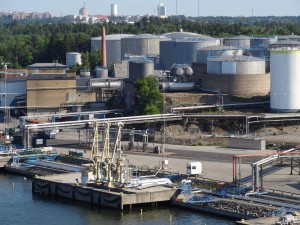 Cartels are formal collusive agreements between firms, typically to fix prices, restrict output or divide up markets. As in the case of monopoly, the lack of competition may harm consumers, who are likely to have to pay higher prices. This, as economic theory demonstrates, results in a reduction in overall welfare.
Cartels are formal collusive agreements between firms, typically to fix prices, restrict output or divide up markets. As in the case of monopoly, the lack of competition may harm consumers, who are likely to have to pay higher prices. This, as economic theory demonstrates, results in a reduction in overall welfare.
For this reason competition authorities throughout the world now impose substantial fines on firms found to be involved in collusive activities and participants also face the threat of substantial jail sentences.
One of the most famous cartels is the Organization of Petroleum Exporting Countries (OPEC). This is an agreement between 12 countries to limit their production of oil. The OPEC cartel has been in place for over 50 years. Arguably, the intergovernmental nature of the cartel and political ramifications of intervening have meant that OPEC has been able to operate free from prosecution for so long.
However, very interestingly Freedom Watch, a US public interest group founded by a former US Department of Justice lawyer, has this week filed a lawsuit against OPEC for violation of competition laws. Quoted in the above press release, Larry Klayman, the founder of Freedom Watch, says that:
These artificially-inflated crude oil prices fall hard on the backs of Americans, many of whom cannot afford to buy gasoline during these severely depressed economic times.
Furthermore, how some of the members use the profits gained from the cartel is also called into question. He also goes on to suggest that the lack of intervention from US government agencies may be because the leaders of both political parties:
… line their pockets from big oil interests and are just sitting back and not doing anything.
This is not the first time that Freedom Watch has served a lawsuit on OPEC. In 2008, at an OPEC meeting in Florida:
In a bold move in front of members of the news media, Freedom Watch Chairman and Chief Legal Counsel Larry Klayman literally jumped out from behind a line of TV cameras and microphones on Friday, October 24, to serve a complaint on an OPEC oil minister.
That complaint was unsuccessful.
It will be fascinating to see the outcome of this latest case and, if successful, the implications for OPEC – updates to appear on this blog in due course.
Articles
Profile: Opec, club of oil producing states BBC News (01/02/12)
OPEC accused of conspiracy against consumers WND World, Bob Unruh (09/05/12)
Freedom Watch Attorney Sues OPEC Oil Minister for Economic Terrorism Conservative Crusader, Jim Kouri (31/10/08)
Lawsuits
Lawsuit brought by Freedom Watch inc. against OPEC (7/5/12)
Lawsuit brought by Freedom Watch inc. against OPEC (9/6/08)
Questions
- Why are cartels so severely punished?
- Why might it be important to punish the individuals involved as well as fine the cartel members?
- Why is fixing the price of oil particularly harmful for the economy?
- Why do you think the OPEC cartel has survived for so long?
- What do you think might be the long term implications of the lawsuit for OPEC?
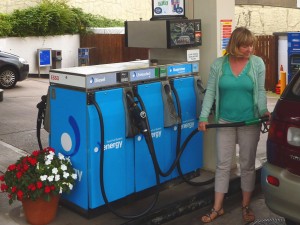 Fuel prices at German petrol stations fluctuate wildly – by up to €0.14 per day. They are also often changed several times per day. In morning rush hours, when demand is less elastic, prices may shoot up, only to drop again once people are at work.
Fuel prices at German petrol stations fluctuate wildly – by up to €0.14 per day. They are also often changed several times per day. In morning rush hours, when demand is less elastic, prices may shoot up, only to drop again once people are at work.
But is this a sign of healthy competition? Critics claim the opposite: that it’s a sign of the oligopoly power of the oil companies. More than two-thirds of Germany’s petrol stations are franchises of five big oil companies: BP/Aral, Esso, Jet, Shell and Total. These five companies directly control the prices at the pumps. According to the Der Spiegel article below, oil companies:
have sophisticated computer systems that allow them to precisely control, right down to the minute, when they increase their prices nationwide, and by how many cents. The prices are not set by the individual franchise holders. Instead, they are centrally controlled – for example, in the town of Bochum, at the headquarters of Aral, a BP subsidiary that is the market leader in Germany.
The price manager merely presses a button and price signs immediately change at all 2,391 Aral service stations in Germany. All filling stations are electronically linked with Bochum via a dedicated network called Rosi. After each price increase, they watch closely to see how the competition reacts and whether they follow suit.
… If the competitor’s prices are significantly cheaper, the Aral franchise holder can, with the help of Rosi, apply for permission to reduce the prices again.
Not only do the oil companies control the prices at the pumps, but they observe closely, via their franchise holders, the actions of their rivals, and then respond in ways which critics claim is collusive rather than competitive. The problem has become worse with the introduction of incentives to the franchise owners of additional commission if they exceed the price of their competitors within the local area. This has the effect of ratcheting prices up.
The sophisticated pricing strategies, with prices adjusted frequently according to price elasticity of demand, are making it very hard for independent operators to compete.
In response, the German Cartel Office has launched an investigation into the oil companies and in particular into the issues of collusion and frequent price changes and how these impact on independent operators.
German anti-trust authority probes alleged fuel cartel Deutsche Welle (4/4/12)
German antitrust watchdog to probe oil majors-paper Reuters, Ludwig Burger (3/4/12)
Oil giants probed over claims they rigged petrol prices in Germany The Telegraph, Nathalie Thomas (4/4/12)
BP, Exxon, Esso, Jet, Shell and Total in Germany Price Fix Probe International Business Times (9/4/12)
German cartel office probes petrol company pricing MarketWatch (4/4/12)
Kartellverfahren gegen fünf Mineralölkonzerne (in German) Frankfurter Allgemeine Zeitung, Helmut Bünder and Manfred Schäfers (4/4/12)
Crazy gas prices driving German consumers mad msnbc, Andy Eckardt (3/4/12)
Big Oil’s Strategy for Jacking Up Gas Prices Der Spiegel, Alexander Jung and Alexander Neubacher (5/4/12)
Questions
- What the features of the German road fuel oligopoly?
- Why does the price elasticity of demand for petrol and diesel vary with the time of day? Is it likely to vary from one week to another and, if so, why?
- In what ways have the actions of the big five oil companies been against the interests of the independent petrol station operators?
- Consider the alternatives open to the German Federal Cartel Office for making the market more competitive.
- Would it be a good idea for the big five German companies to be forced to adopt the Western Australian system of price changes?
In many parts of the UK, bus services are run by a single operator. In other parts, it is little different, with the main operator facing competition on only a very limited number of routes. Over the whole of England, Scotland and Wales there are 1245 bus operators, but the ‘big five’ (Arriva, FirstGroup, Go-Ahead, National Express and Stagecoach) carry some 70% of passengers. Generally these five companies do not compete with each other, but, instead, operate as monopolies, or near monopolies, in their own specific areas. On average, the largest operator in an urban area runs 69% of local bus services.
Given this lack of competition and potential abuse of monopoly power, the Office of Fair Trading referred local bus services in Great Briatin (excluding London) to the Competition Commission (CC) in January 2010. The CC has just published its final report. Paragraph 5 of the summary to the report states:
We concluded that there were four features of local bus markets which mean that effective head-to-head competition is uncommon and which limit the effectiveness of potential competition and new entry. These features are the existence of: high levels of concentration; barriers to entry and expansion; customer conduct in deciding which bus to catch; and operator conduct by which operators avoid competing with other operators in ‘Core Territories’ (certain parts of an operator’s network which it regards as its ‘own’ territory) leading to geographic market segregation.
And paragraph 8 states:
We decided on a package of remedies with three main elements to address the AECs [adverse effects on competition] that we found. First, the remedies include market-opening measures to reduce barriers to entry and expansion, thereby reducing market concentration and providing an environment in which competition is likely to be sustained. By reducing barriers to entry and expansion, we also expect it to become harder for operators to sustain a coordinated outcome. Second, the remedies include measures to promote competition in relation to the tendering of contracts for supported services. Third, we made recommendations about the wider policy and regulatory environment, including emphasizing compliance with and effective enforcement of competition law.
The following articles look at the findings of the report and at the potential for improving the service to passengers, in terms of quality, frequency and price.
Articles
Competition regulator outlines bus market shake-up The Telegraph (20/12/11)
Bus market not competitive, Competition Commission says BBC News (20/12/11)
Passengers ‘need more bus rivalry’ Press Association (20/12/11)
Competition Commission publications
CC sets out Future Destination for Bus Market Competition Commission News Release (20/12/11)
Bus Market Inquiry: Final Report, Case Studies and Appendices Competition Commission (20/12/11)
Local Bus Services: Accompanying Documents Competition Commission (20/12/11)
Questions
- What are the barriers to entry in the market for local bus services?
- In what circumstances are local bus services a natural monopoly? Is this generally the case?
- In a non-regulated bus market, how could established operators use predatory pricing to drive out new entrants?
- How may offering reductions for return tickets reduce competition on routes where there is a large operator and one or more smaller ones?
- What practices can established large operators use to drive out smaller competitors?
- Go through the four reasons given by the CC why head-to-head competition in local bus markets is uncommon and in each case consider what remedies could be adopted by the regulator or by local authorities.
- Which of the remedies proposed by the CC involve encouraging more competition and which involve tighter regulation?
 When crude oil prices go up, the prices of petrol and diesel go up pretty well straight away and by the full amount, or more, of the crude price rise. When crude prices go down, however, road fuel prices are often slow to fall; and when they do, the fall is less than the full fall in crude prices.
When crude oil prices go up, the prices of petrol and diesel go up pretty well straight away and by the full amount, or more, of the crude price rise. When crude prices go down, however, road fuel prices are often slow to fall; and when they do, the fall is less than the full fall in crude prices. Formal inquiry tries to ease motorist pain at the pumps ITV News, Laura Kuenssberg (5/9/12)
Formal inquiry tries to ease motorist pain at the pumps ITV News, Laura Kuenssberg (5/9/12)



